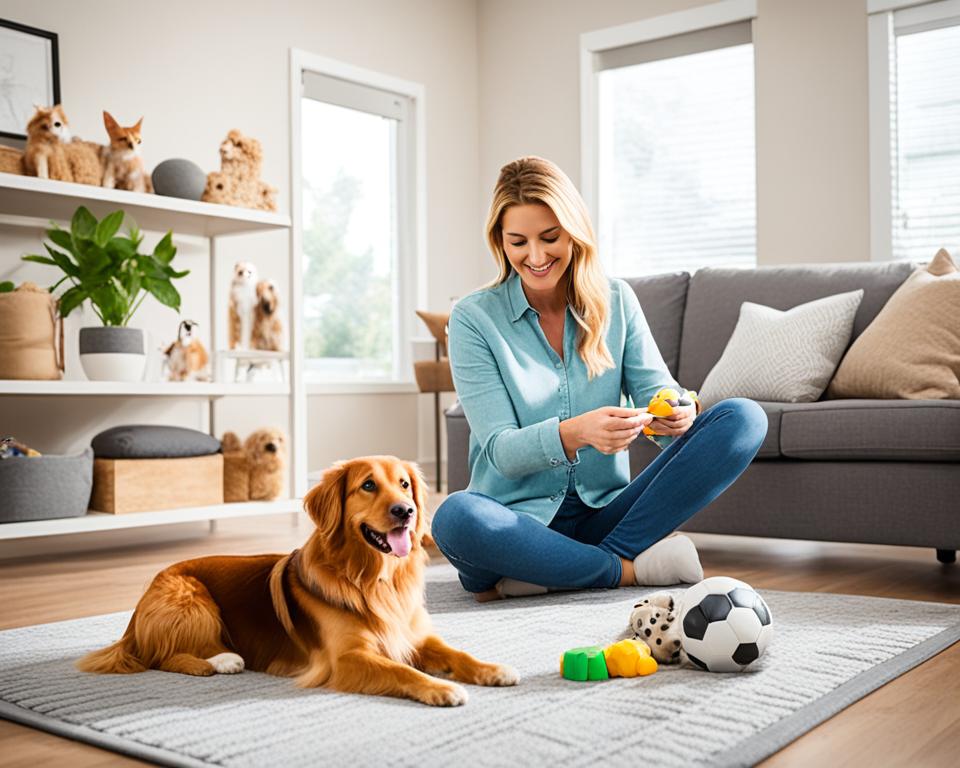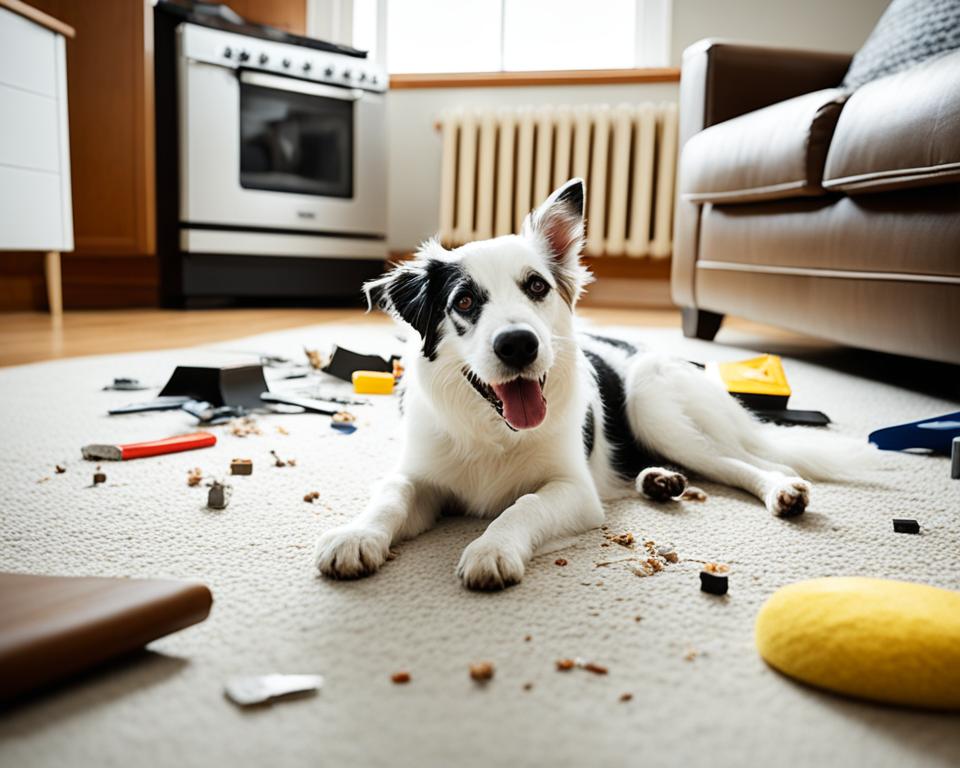Pet behavior problems can really strain the bond between owners and their pets. Issues like aggressive behavior or destructive chewing can be tough and sad. As a pet lover, I know it’s key to tackle these problems head-on.
Did you know that bad behavior is a top reason pets are given up? It’s a sad fact, but there’s hope. By figuring out why pets act out, we can find ways to fix it. Things like health issues, stress, and not enough training affect how pets behave.
Fixing these problems takes time, patience, and sometimes expert advice. Whether it’s dogs with separation anxiety or cats that soil the house, there are ways to help. Let’s look at some solutions to make pets happier and strengthen our bond with them.
Understanding the Root Causes of Pet Behavior Issues
Pet behavior problems come from many sources. I’ve seen how health issues, stress, and not enough training cause problems like too much barking and litter box issues. Let’s look at the main reasons behind these tough behaviors.
Medical Conditions as Underlying Factors
Many pet owners don’t know that health problems can change a pet’s behavior. For instance, kidney disease in cats might make them pee outside the litter box. Dogs with Canine Cognitive Dysfunction can get confused and anxious.
Stress and Environmental Changes
Pets feel the world around them deeply. A new baby, moving, or even changing furniture can make them stressed. I’ve seen that pets get separation anxiety when their routine or home changes suddenly.
Lack of Proper Socialization and Training
How pets experience the world early on affects their behavior. Without getting used to different people and animals, they might be scared or aggressive. Not training them well can lead to too much barking or chewing things they shouldn’t.
| Behavior Issue | Possible Root Cause | Percentage of Affected Pets |
|---|---|---|
| Aggression | Lack of Socialization | 36.1% (dogs) |
| Litter Box Issues | Medical Conditions | 19.7% (cats) |
| Separation Anxiety | Environmental Changes | 14% (dogs and cats) |
Knowing the root causes of pet behavior issues is key to fixing them. By finding out what’s really going on, we can make plans to help our pets live happier, more balanced lives.
Common Pet Behavior Problems and Their Manifestations
As a pet owner, I’ve seen many pet behavior problems. These can be simple annoyances or big issues that affect everyone at home. Let’s look at some common problems and how they show up in our pets.

Aggressive pets are a big worry for many owners. This can show as growling, snapping, or biting. It’s not just dogs; cats can be aggressive too. In fact, aggression is the top issue in vet offices, making up about 70% of cases.
Destructive chewing is another big problem. I’ve lost track of how many shoes and furniture my dog has chewed up! This usually comes from being bored, anxious, or having too much energy. Giving them the right chew toys and making sure they get enough exercise can help.
Excessive barking or meowing can really get on a pet owner’s nerves. Dogs bark for many reasons – to alert us, get attention, or because they’re bored. Cats meow a lot when they’re hungry or want attention. Training and finding out why they’re doing it are important to fix these issues.
| Behavior Problem | Possible Causes | Manifestations |
|---|---|---|
| Aggression | Fear, pain, territorial instincts | Growling, biting, snapping |
| Destructive Chewing | Boredom, anxiety, teething | Damaged furniture, shoes, belongings |
| Excessive Vocalization | Attention-seeking, anxiety, alerting | Constant barking or meowing |
Understanding these pet behavior problems is the first step in fixing them. Remember, being patient and training consistently are key to making our pets good companions.
The Impact of Pet Behavior Problems on the Human-Animal Bond
Pet behavior problems can deeply affect the bond between pets and their owners. These issues can create stress and tension in homes across the United States. Let’s look at the emotional toll, family dynamics, and social challenges they bring.
Emotional Toll on Pet Owners
Living with pets that have behavior issues can be emotionally draining. A study found dog and cat owners felt many emotions:
- Sadness
- Frustration
- Embarrassment
- Fear
Some owners even thought about putting their pets down because of their behavior. This shows how much these issues affect us.
Strain on Family Dynamics
Pet behavior problems can disrupt family life. Aggressive pets or those with separation anxiety cause stress at home. During the COVID-19 lockdowns, many families saw changes in their pets.
A study found a 1.8 times increase in negative behavior changes in dogs. This includes things like excessive barking or anxiety.
Public Perception and Social Challenges
Problematic pet behavior can lead to social isolation. Owners may avoid public places or feel judged. This was true during the pandemic, when dog bites involving children went up.
Pet owners often get little understanding from friends and some professionals about their pets’ behavior issues.
| Impact | Percentage |
|---|---|
| Negative behavior changes in dogs during lockdown | 180% increase |
| Positive behavior changes in cats during pandemic | 33% of owners reported |
| Increase in dog bites involving children (2020 vs. previous years) | Significant increase |
Understanding these impacts is key to supporting pet owners. We need to develop strategies to help with pet behavior problems.
Recognizing Signs of Fear, Anxiety, and Stress in Pets
As a pet owner, I’ve learned it’s key to spot signs of distress in our furry friends. Pets can’t tell us when they’re scared or anxious. It’s up to us to notice their cues. This is vital for issues like excessive barking or separation anxiety.

Dogs often show stress through physical changes. I’ve seen dogs pant a lot or shed more when they’re anxious, even if they haven’t been active. Dilated pupils, rapid blinking, and showing the whites of their eyes are signs too. Body language is also telling – a tucked tail or stiff posture can mean fear.
Behavioral changes are also key to watch for. Excessive barking might mean a dog is anxious, especially when left alone. Some dogs pace, hide, or do repetitive behaviors like licking or chewing. These actions can show separation anxiety or stress.
Cats have their own ways of showing stress. Litter box issues can happen when cats are anxious or scared. They might groom too much or be more vocal than usual. I’ve seen cats hide more or become clingy when stressed.
- Excessive yawning or licking lips
- Avoiding eye contact
- Sudden changes in appetite
- Increased aggression or fearfulness
Spotting these signs early can help stop behavior problems from getting worse. If you see signs of fear or anxiety in your pet, talk to a vet or animal behaviorist for advice.
Positive Reinforcement Techniques for Behavior Modification
Positive reinforcement changes the game for pet behavior issues. It’s about rewarding good actions, not punishing bad ones. This method is great for aggressive pets and stops destructive chewing.
Reward-Based Training Methods
Timing is everything in positive reinforcement. I reward my pet right after they do what I want. Using “sit,” “stay,” and “come” helps avoid confusion. Food treats and praise work well too!
Consistency and Patience in Training
When teaching a new behavior, I reward at first, then less often. This keeps my pet interested. Being patient is key, as changing behavior takes time. I take small steps and reward each improvement.
Building Trust Through Positive Interactions
Trust is key for good pet behavior. I use desensitization to help my pet get used to tough situations. Counterconditioning replaces bad behaviors with good ones through rewards. The aim is to encourage good actions, not just stop the bad ones.
Modern training methods emphasize focusing on behavior solutions rather than being absorbed by behavior problems.”
Using these positive methods has greatly improved my pet’s behavior. It’s incredible how a bit of positivity can change even tough pets!
Creating a Supportive Environment for Behavioral Improvement
Making a supportive home is key to fixing pet behavior issues. With a few changes at home, you can help your pet with problems like too much barking, litter box troubles, and separation anxiety.
For dogs with separation anxiety, I suggest creating a safe spot. This could be a cozy corner with their favorite bed and toys. Getting them used to your leaving can help a lot. Start with short times away and slowly increase it.

Cats with litter box issues need the right spot. Keep the box quiet and easy to get to. Clean it often. For dogs who bark too much, lots of exercise and fun activities can help.
Here’s a quick guide to making a pet-friendly home:
- Maintain a consistent daily routine
- Provide appropriate outlets for normal behaviors
- Minimize exposure to stressful situations
- Use positive reinforcement to encourage good behavior
Fixing behavior problems early is key. Most dogs end up in shelters because of behavior issues. By making a supportive home, you’re not just solving problems. You’re also making your bond with your pet stronger.
| Behavior Problem | Environmental Solution |
|---|---|
| Excessive Barking | Provide puzzle toys and regular exercise |
| Litter Box Issues | Ensure clean, accessible litter boxes |
| Separation Anxiety | Create a safe space, gradual desensitization |
Pet Behavior Problems: Solutions for Different Species
Pet behavior problems change a lot across species. Each pet has its own needs and challenges. Let’s look at some common issues and how to solve them for different pets.
Addressing Common Dog Behavior Issues
Dogs often have problems like being aggressive or chewing things they shouldn’t. Did you know aggression is in about 70% of dog behavior cases in North America? To fix these issues, I use positive reinforcement and act early.
- Use reward-based training to encourage good behavior
- Provide appropriate chew toys to prevent destructive chewing
- Socialize puppies early to reduce fear-based aggression
Resolving Feline Behavioral Challenges
Cats have their own set of problems. Issues like not using the litter box or scratching furniture are common. I’ve found that knowing what cats naturally do helps solve these problems.
- Offer multiple litter boxes in quiet areas
- Provide scratching posts near favorite spots
- Create separate territories for multi-cat homes
Unique Solutions for Other Pets
Birds, rabbits, and other small pets need special solutions. Their behaviors can be complex and often misunderstood. It’s important to learn about your pet’s natural habits to solve any issues.
| Pet Type | Common Problem | Solution |
|---|---|---|
| Birds | Excessive screaming | Regular interaction, toys for mental stimulation |
| Rabbits | Digging | Provide a designated digging area |
| Hamsters | Biting | Handle gently, avoid waking during sleep |
Remember, patience is key when dealing with pet behavior problems. Each pet is different, so what works for one might not work for another. By understanding your pet’s needs and using positive methods, you can make your home happier for both you and your pet.
When to Seek Professional Help for Pet Behavior Problems
Dealing with pet behavior problems can be tough. If home remedies don’t help, it’s time to get expert advice. This is key for issues like aggressive pets or those with separation anxiety. Experts like Certified Professional Dog Trainers (CPDTs) and Applied Animal Behaviorists are great at solving these problems.
If your pet’s behavior is really stressful, look for pros with advanced degrees and lots of experience. Veterinary Behaviorists are top-notch because they’ve done special training and passed tough exams. They can check if a medical issue is making the behavior worse.
When picking a pro, make sure to talk to them a lot and ask for references from past clients or vets. It’s important to find someone who uses kind methods, not harsh ones. While fixing pet behavior isn’t always easy, the right expert can really help. This can make life better for pets and their owners.

